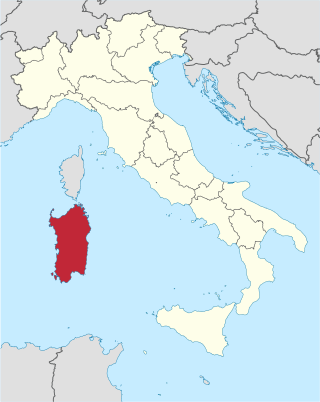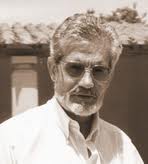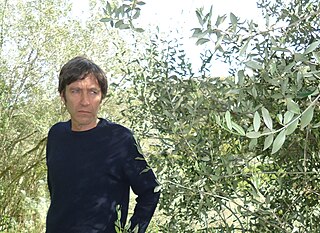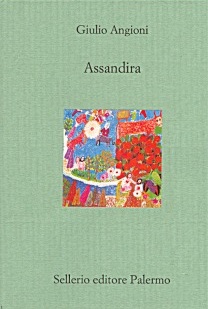Sardinian Literary Spring is a definition of the whole body of the literature produced in Sardinia from around the 1980s onwards.
Sardinian Literary Spring, also known as Sardinian Literary Nouvelle Vague, [1] is a denomination normally used to describe the literary works written by Sardinians from around the 1980s. It is described as being formed of novels and other written texts (and sometimes also of cinema, theatre and other works of art), which often share stylistic and thematic constants. [2] They form a kind of fiction with features that derive mainly, but not only, from the Sardinian, Italian, and European context and history. [3]
The Sardinian Literary Spring is considered to be one of the most remarkable regional literatures in Italian, [4] [5] but sometimes also written in one of the island's minority languages (the most prominent of which being the Sardinian language, in addition to the other Romance varieties spoken in Sardinia, namely Corsican, Catalan, and Genoese). [6] [7] [8]
The definition of 'spring' [9] or 'nouvelle vague' [10] or plainly 'new Sardinian literature' is due to the new quality, quantity, and international success of many works published by these Sardinian authors, [11] translated in many world languages. [12]
The Sardinian Literary Spring was started, according to a mostly shared canonical opinion, [13] [14] [15] by a trio formed of Giulio Angioni, Sergio Atzeni and Salvatore Mannuzzu, and then continued by authors such as Salvatore Niffoi, Alberto Capitta, Giorgio Todde, Michela Murgia, Flavio Soriga, Milena Agus, Francesco Abate, and many others.
The Sardinian Literary Spring is considered to be also the contemporary result, in the European arena, [16] of the works of Sardinian individual prominent figures such as Grazia Deledda, Nobel Prize winner for literature in 1926, Emilio Lussu, Giuseppe Dessì, Gavino Ledda, Salvatore Satta, and others. [17]
Sergio Atzeni (1952 - 1995) [18] [19] worked for some of the most important Sardinian newspapers. Member of the Italian Communist Party, but later disillusioned with politics, he left Sardinia and travelled across Europe. All of Atzeni's works are set in Sardinia. He used a very original language that fused elegant literary Italian and the "patter" used by the working-class in Cagliari and Sardinia. In some of his novels (e.g. Il quinto passo è l'addio and Bellas mariposas) he also used techniques akin to the magic realism style of many Southern American authors, [20] and he has been followed by other Sardinian authors, such as Alberto Capitta, Giorgio Todde, and Salvatore Niffoi, who in 2006, with the novel La vedova scalza (The barefoot widow), won the popular Premio Campiello.
Giulio Angioni [21] [22] (born 1939) is a leading Italian anthropologist. [23] He is also well known as the author of about twenty books of fiction and poetry. [24] [25] Angioni writes mostly in Italian, but also in Sardinian. He has inaugurated a linguistic style which switches from the standard Italian to the regional (Sardinian) Italian and other linguistic varieties, in an original mixture of his own, but also followed by other Sardinian authors. [26] Angioni's best novels are considered to be Le fiamme di Toledo (Flames of Toledo), Assandira , La pelle intera, [27] [28] Doppio cielo (Double sky), L'oro di Fraus. [29] (The gold of Fraus). [30]
Salvatore Mannuzzu’s (born 1930) most successful novel is Procedura (1988, Einaudi), winner of Italy's Premio Viareggio in 1989. In 2000 the director Antonello Grimaldi has made the film Un delitto impossibile from this novel, which is also considered (with the coeval L'oro di Fraus by Giulio Angioni) the origin of a genre of Sardinian detective stories [31] (called giallo sardo). [32] [33] [34] with authors such as Marcello Fois [35] and Giorgio Todde, who gave birth to the Literary Festival of Gavoi, L'isola delle storie, with Giulio Angioni, Flavio Soriga, and other authors. [36]
{{cite web}}: CS1 maint: numeric names: authors list (link)Eduardo Blasco Ferrer was a Spanish-Italian linguist and a professor at the University of Cagliari, Sardinia. He is best known as the author of several studies about the Paleo-Sardinian and Sardinian language.

Grazia Maria Cosima Damiana Deledda was an Italian writer who received the Nobel Prize for Literature in 1926 "for her idealistically inspired writings which with plastic clarity picture the life on her native island [i.e. Sardinia] and with depth and sympathy deal with human problems in general". She was the first Italian woman to receive the prize, and only the second woman in general after Selma Lagerlöf was awarded hers in 1909.

Sardinian or Sard is a Romance language spoken by the Sardinians on the Western Mediterranean island of Sardinia.

Sardinia is the second-largest island in the Mediterranean Sea, after Sicily, and one of the twenty regions of Italy. It is located west of the Italian Peninsula, north of Tunisia and 16.45 km south of the French island of Corsica.
Sergio Atzeni was an Italian writer.
Gerolamo Araolla, also known as Hieronimu Araolla, was a Sardinian poet and priest.

The Sardinians, or Sards, are a Romance language-speaking ethnic group native to Sardinia, from which the western Mediterranean island and autonomous region of Italy derives its name.

The Perfect Fusion was the 1847 act of the Savoyard King Charles Albert of Sardinia which abolished the administrative differences between the mainland states and the island of Sardinia within the Kingdom of Sardinia, in a fashion similar to the Nueva Planta decrees between the Crown of Castile and the realms of the Crown of Aragon between 1707 and 1716 and the Acts of Union between Great Britain and Ireland in 1800.
Nicola Tanda was an Italian philologist and literary critic. He studied under Ungaretti and Sapegno at Rome. He was for over thirty years professor at the University of Sassari, first specialising in Italian literature, and then later in Sardinian philology and Sardinian literature. He was a leading advocate for minority languages and their literary expression in the island of Sardinia, including the Sardinian language and Algherese Catalan. As such he was an honorary member of ANPOSDI. He wrote the new Philology of Italians based on the European Charter for Regional or Minority Languages. He was founder and president of the Sardinian PEN Club. He was president of the jury of the Premio Ozieri literary prize founded in 1956 to promote new works composed in Sardinian tongues. He founded in 2003 the Centre for Study of Sardinian Philology. As an editor/director he has guided the publication of over 100 volumes written in Sardinian languages.

Sardinian nationalism or also Sardism is a social, cultural and political movement in Sardinia calling for the self-determination of the Sardinian people in a context of national devolution, further autonomy in Italy, or even outright independence from the latter. It also promotes the protection of the island's environment and the preservation of its cultural heritage.

Giulio Angioni was an Italian writer and anthropologist.

Giovanni Lilliu, was a renowned archeologist, academician, publicist and politician and public figure and an expert of the Nuragic civilization. Largely due to his scientific and archeologic work in the Su Nuraxi di Barumini in Sardinia, Italy, the site was inscribed on the UNESCO list of World Heritage Sites in 1997.

The literature of Sardinia is the literary production of Sardinian authors, as well as the literary production generally referring to Sardinia as an argument, written in various languages.

Salvatore Mannuzzu was an Italian writer, politician, and magistrate.

Salvatore Niffoi is an Italian writer.

Alberto Capitta is an Italian writer.

Flavio Soriga is an Italian writer.

Assandira is a novel by Giulio Angioni, published in 2004 by Sellerio.

Milena Agus is an Italian author from Sardinia. She is one of the leading novelists in the so-called Sardinian Literary Spring which began in the 1980s and which includes other international names such as Michela Murgia.

Salvatore Satta was an Italian jurist and writer. He is famous for the novel The Day of Judgment (1975), and for several important studies on civil law.